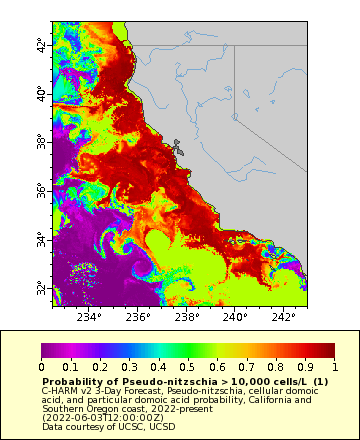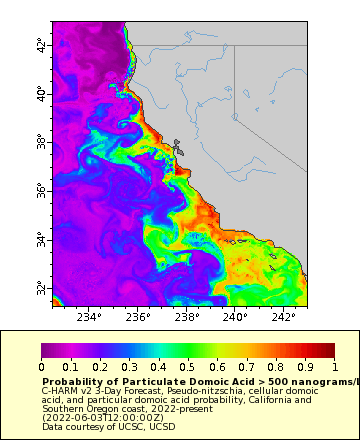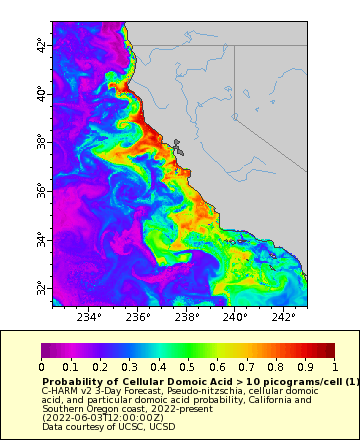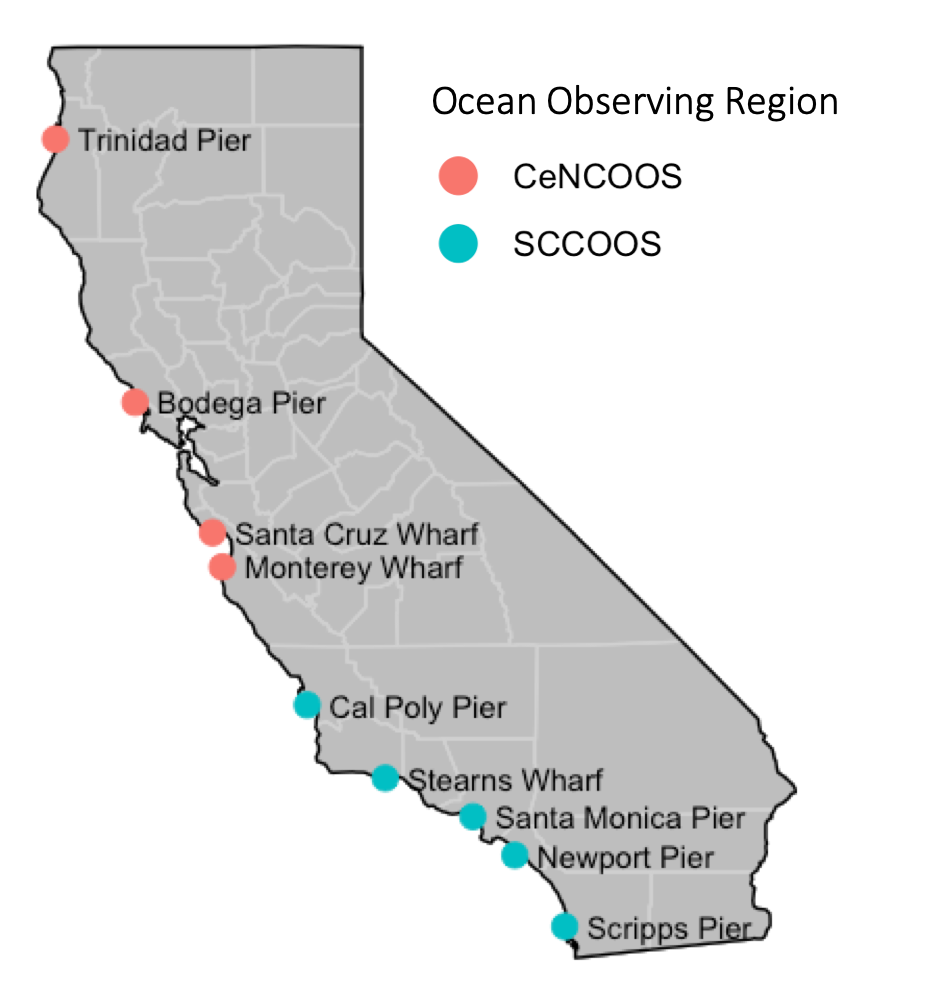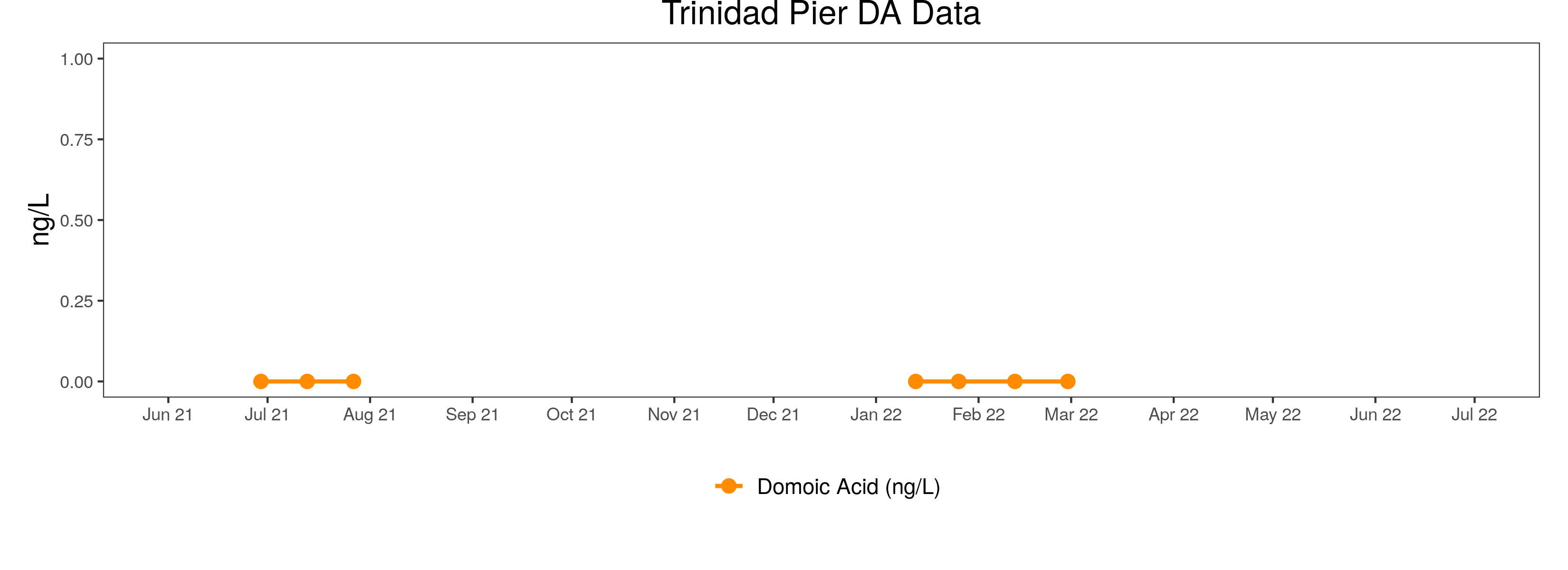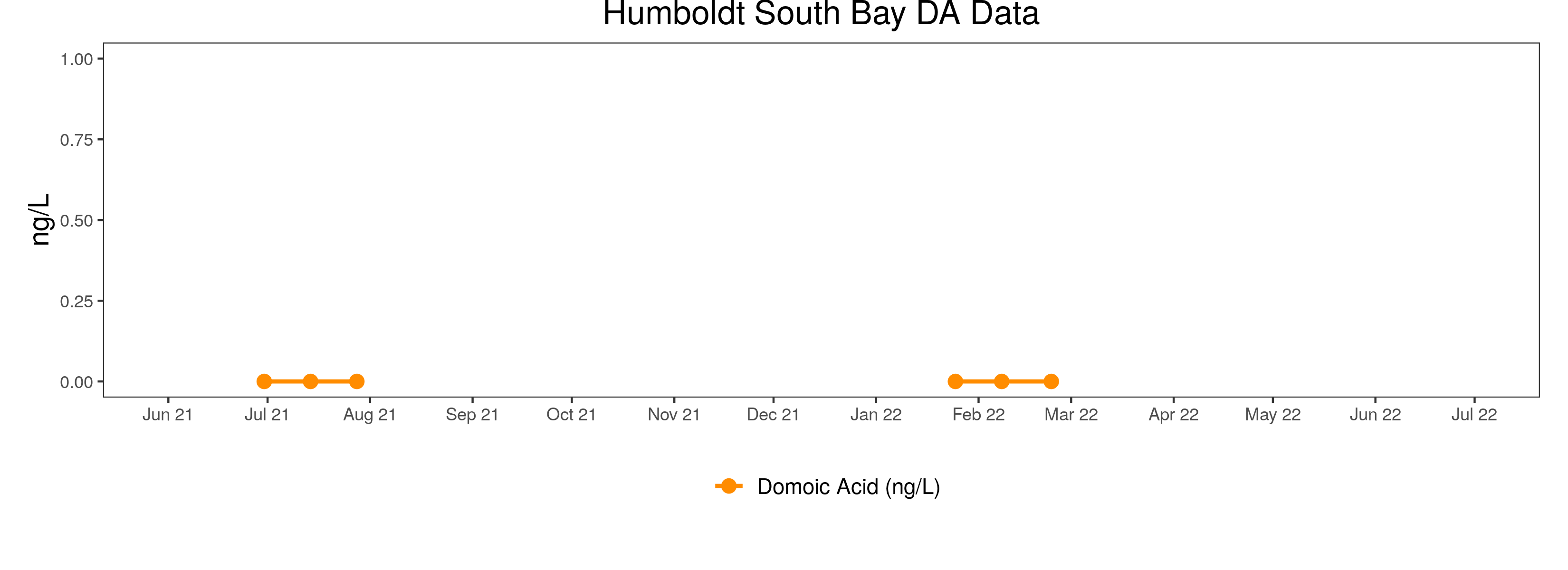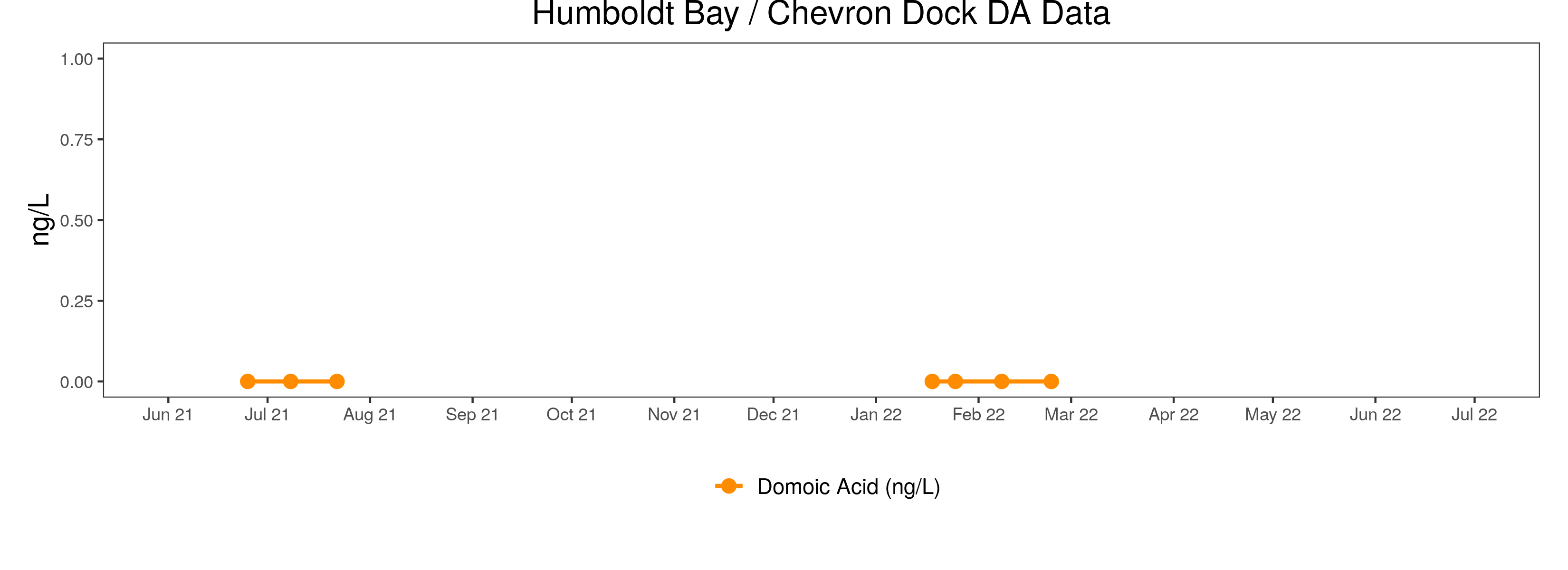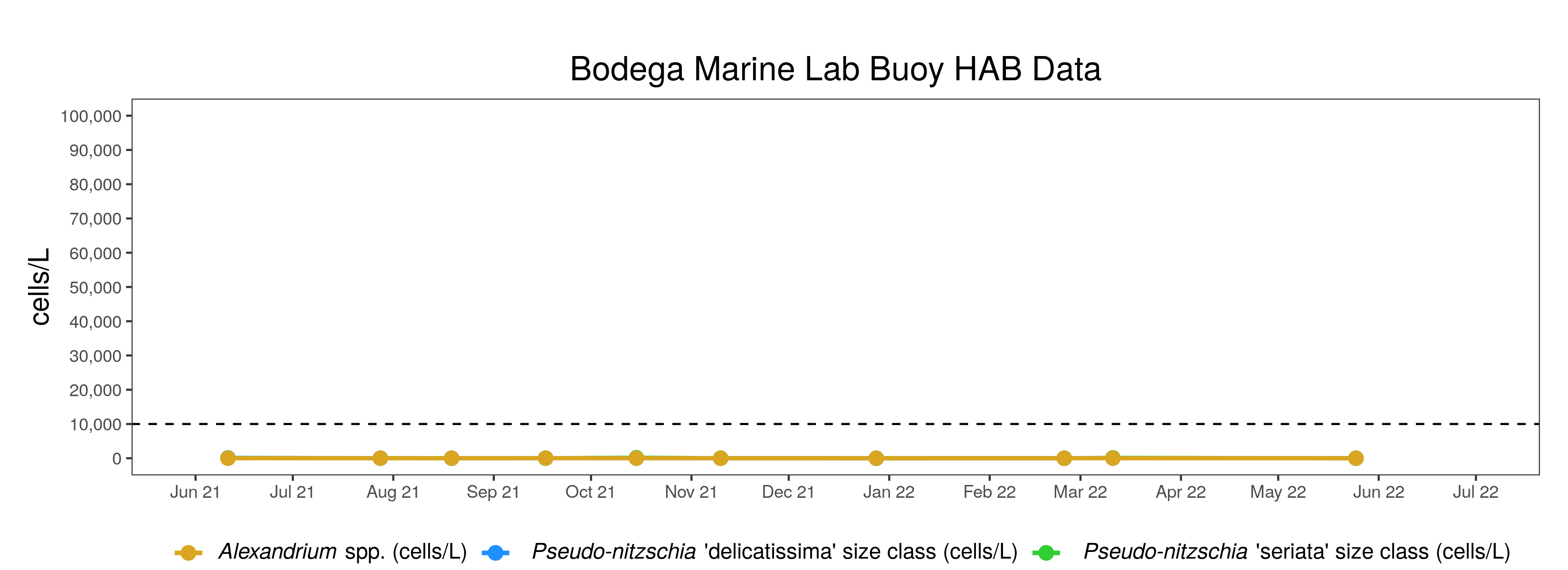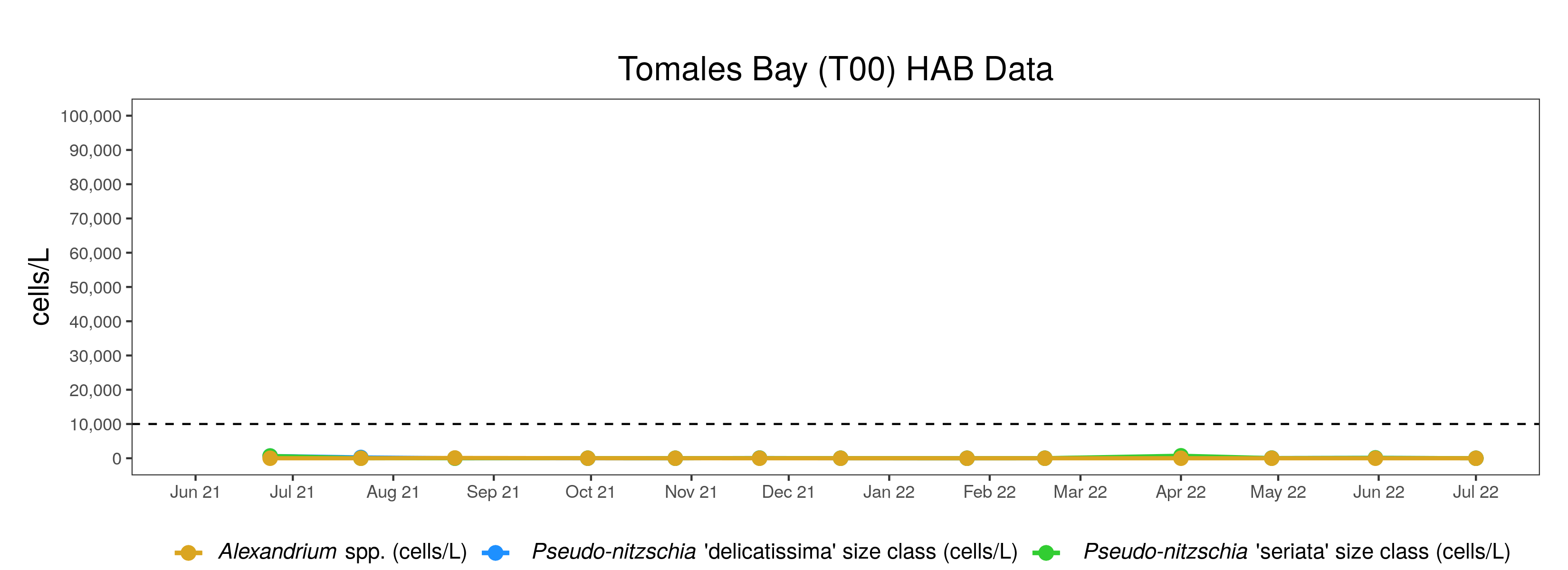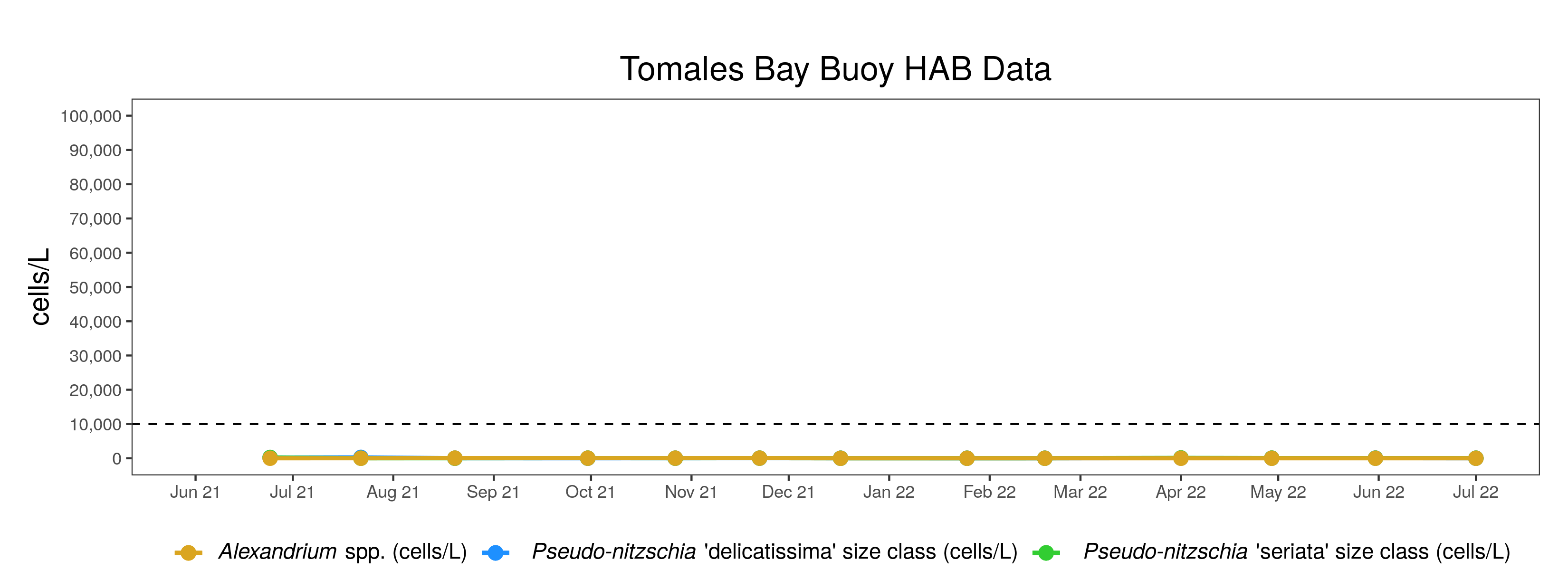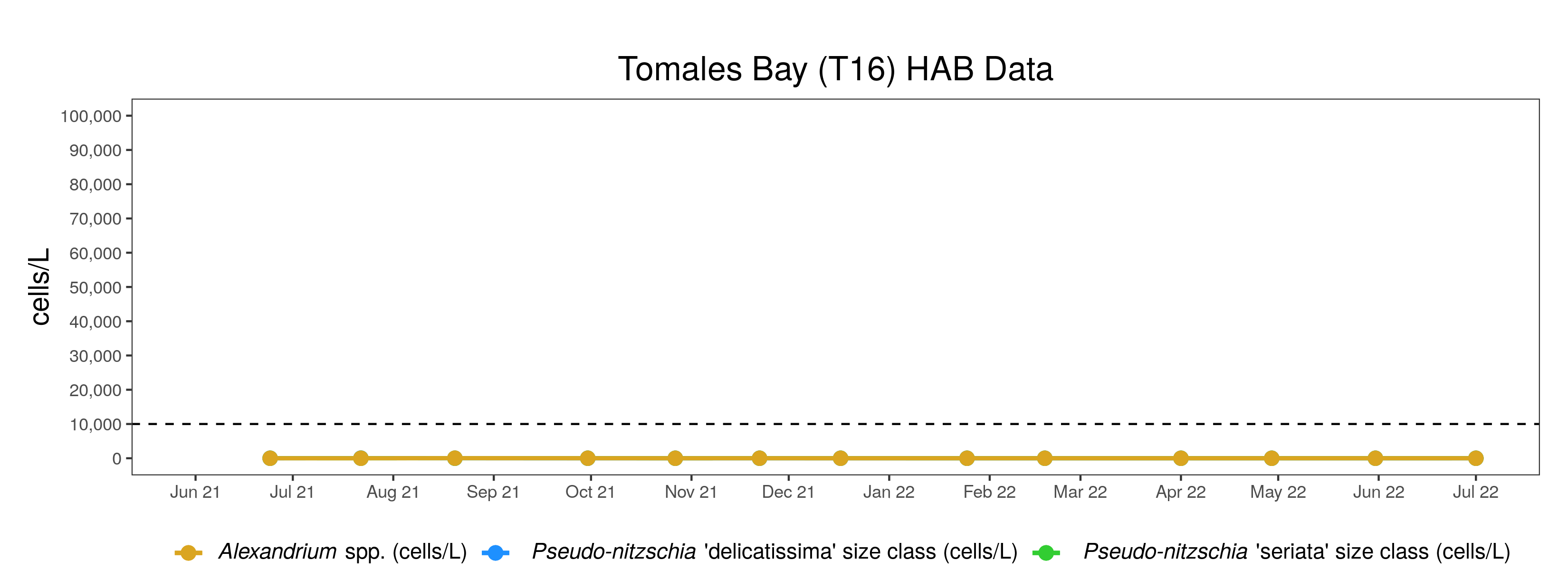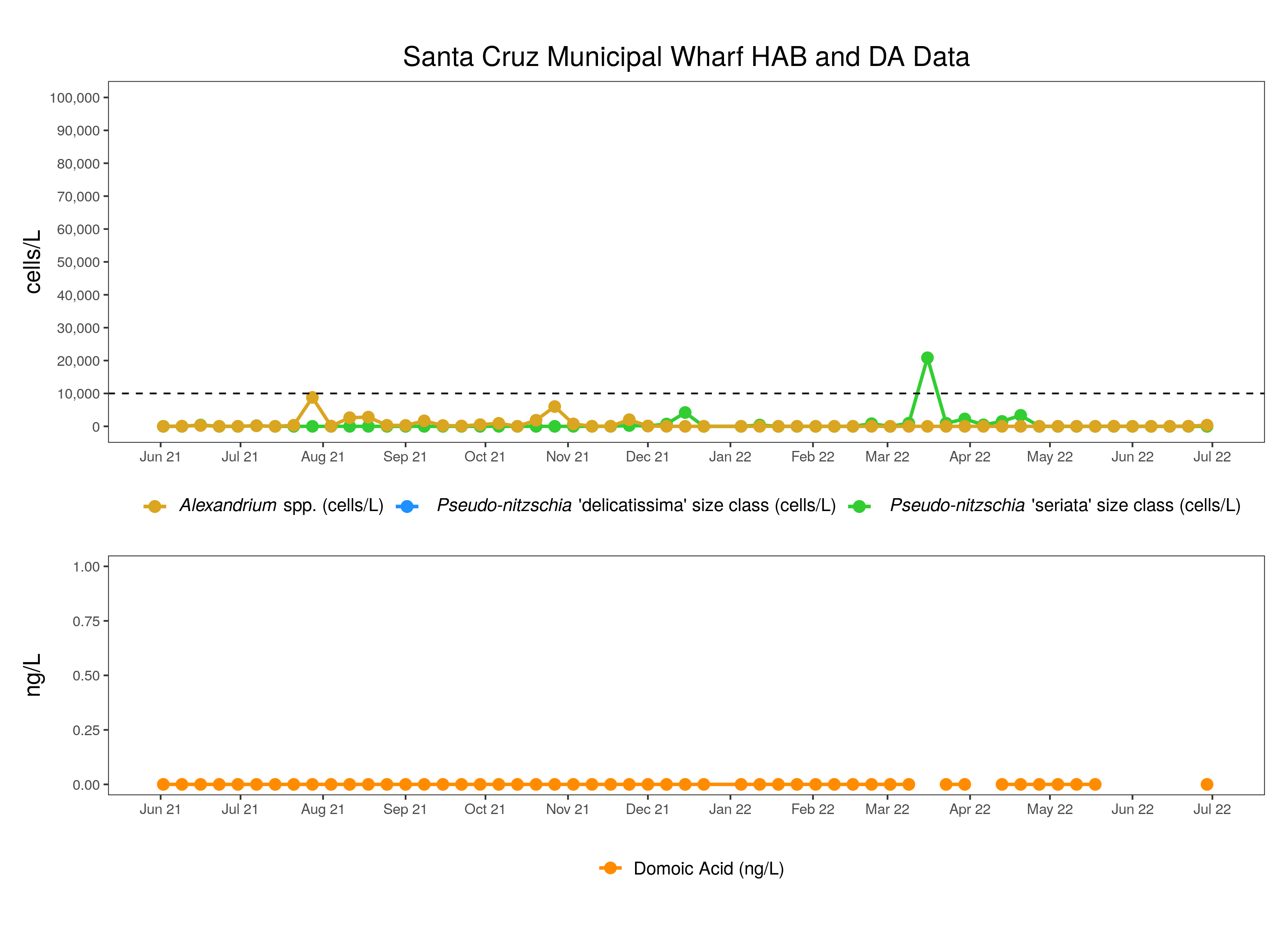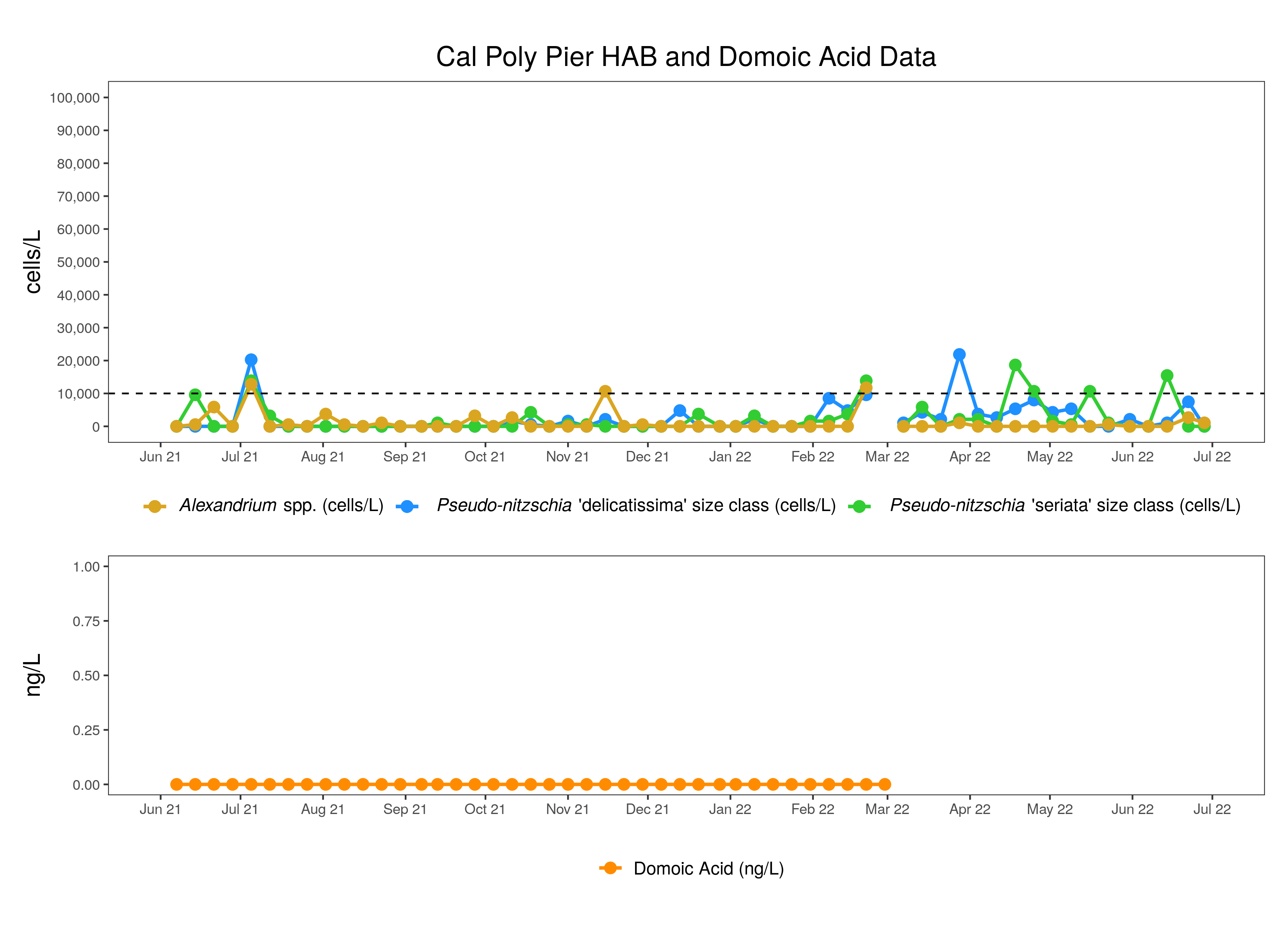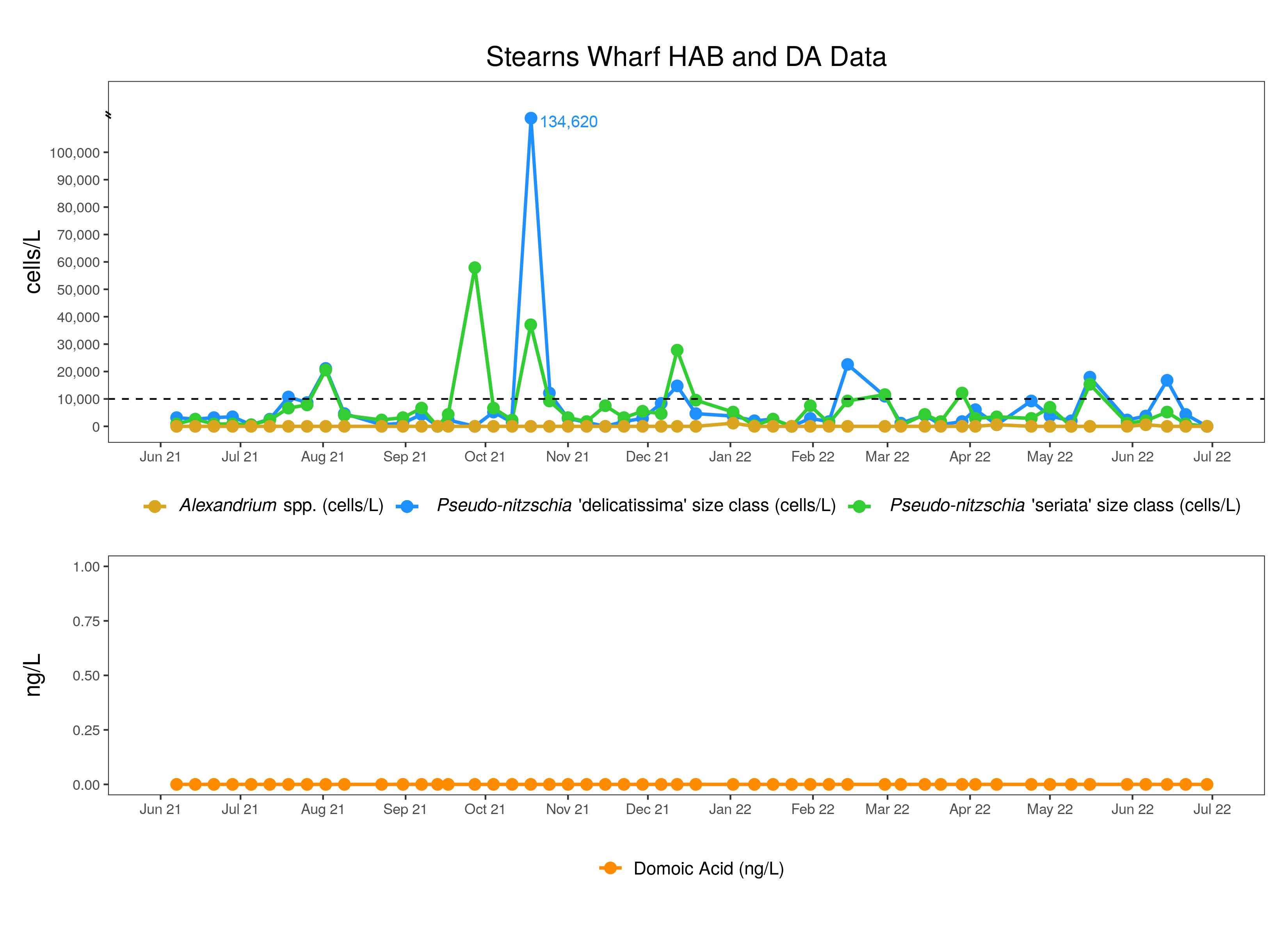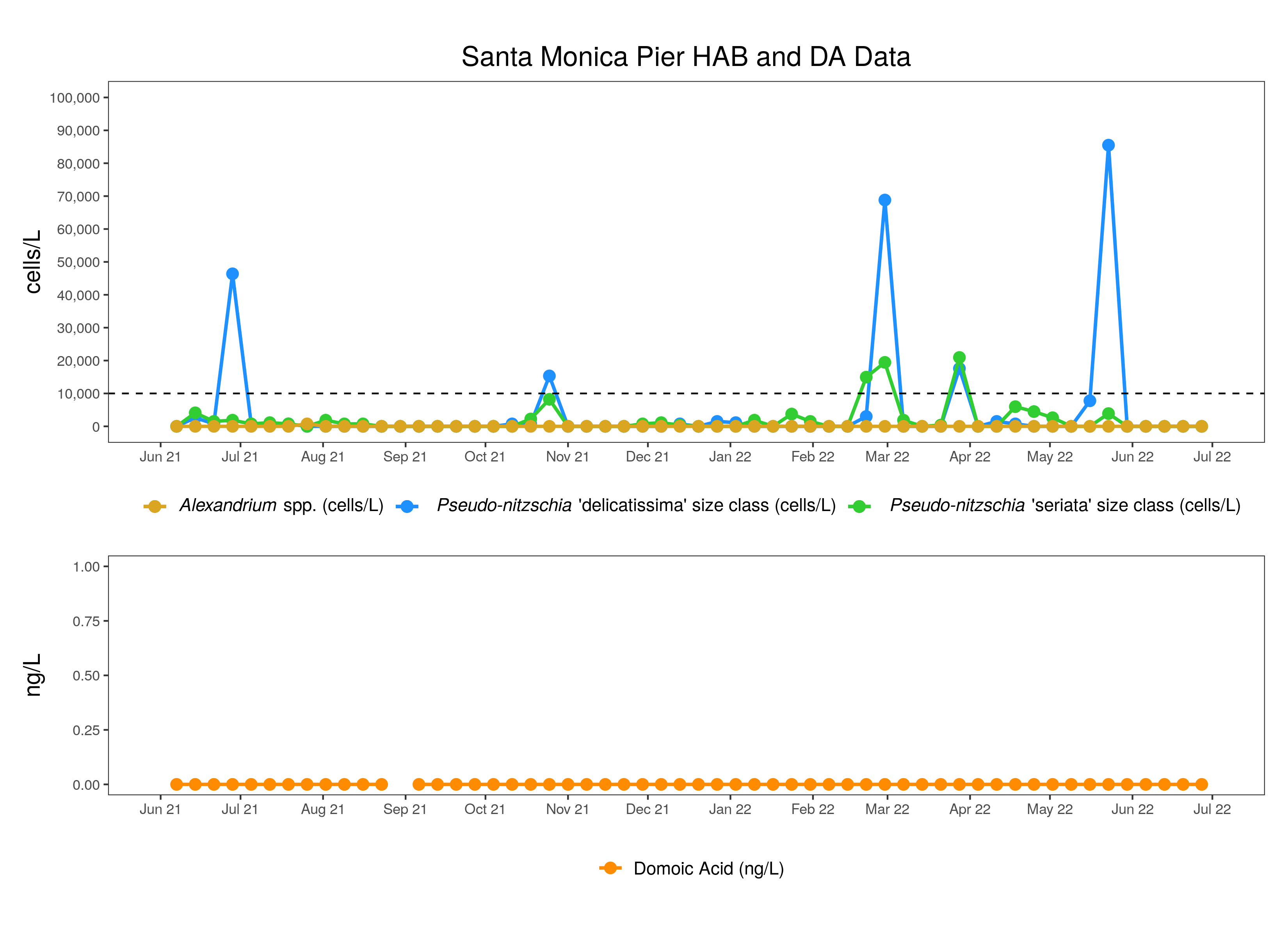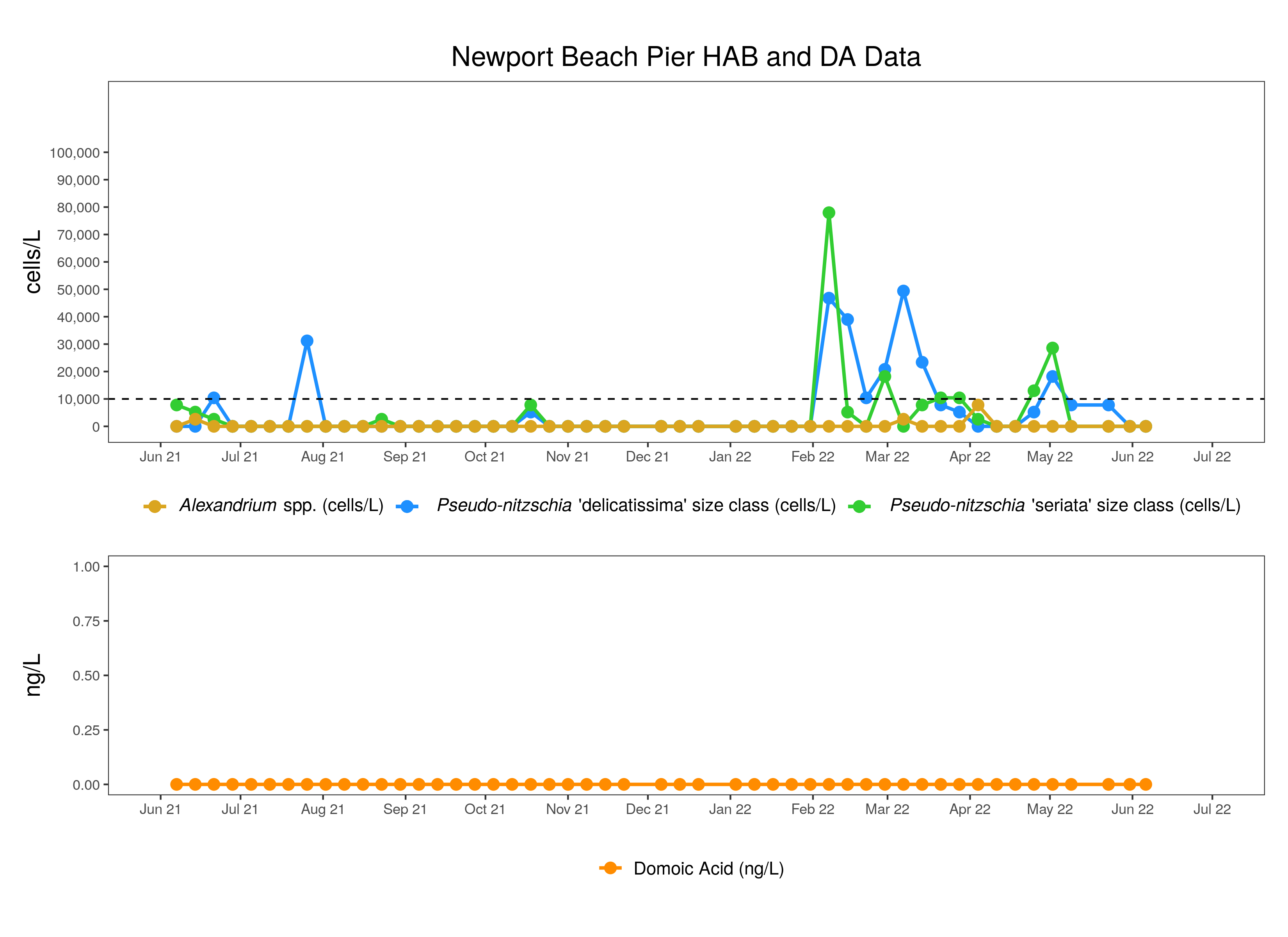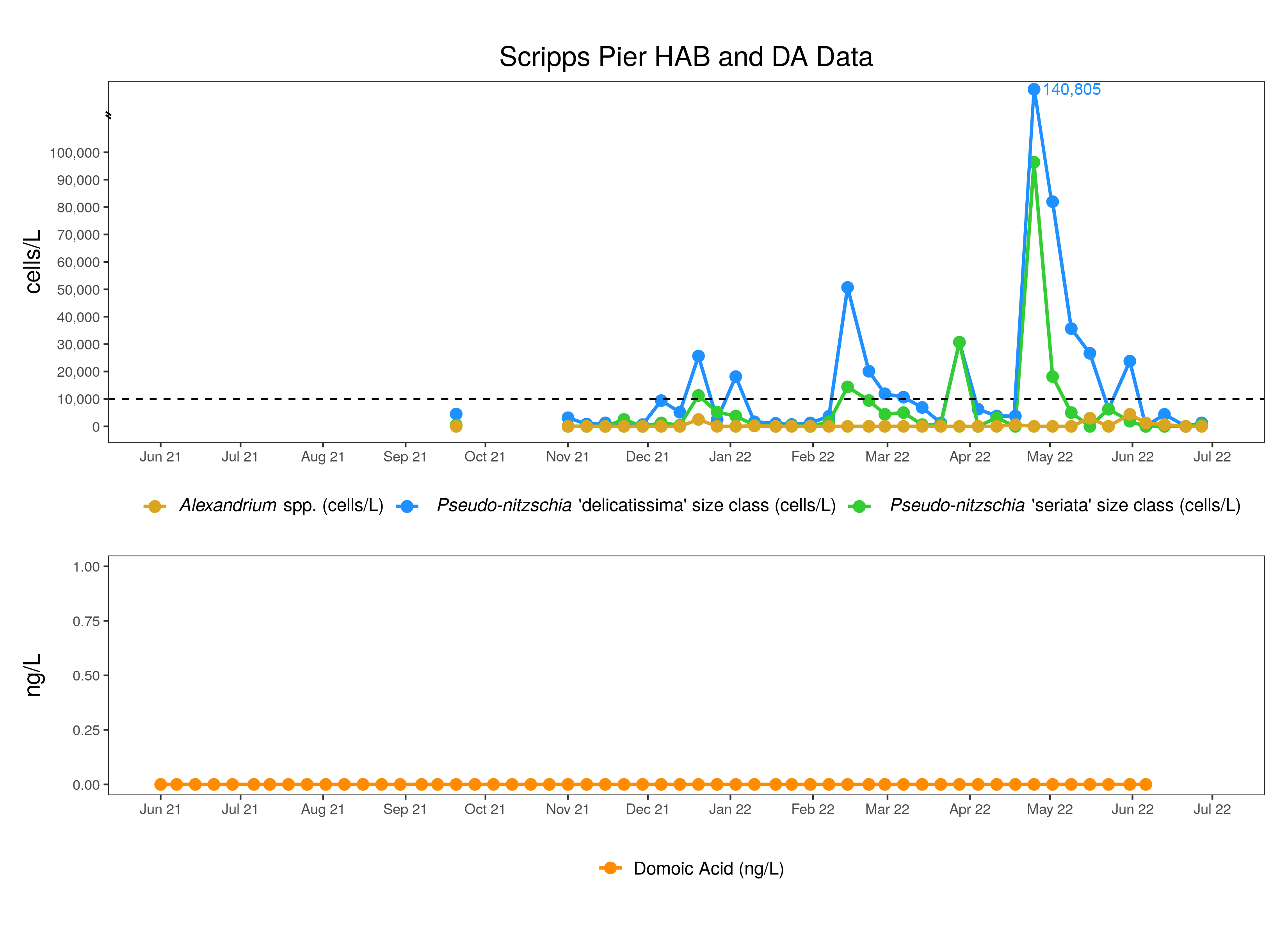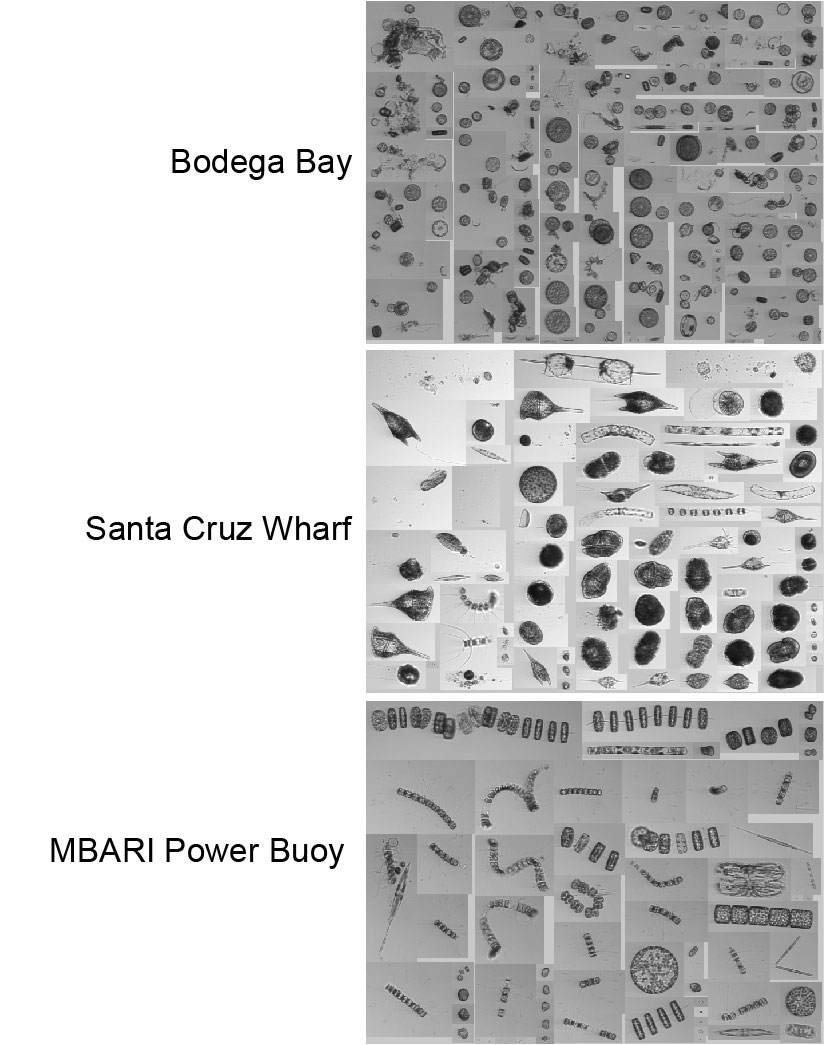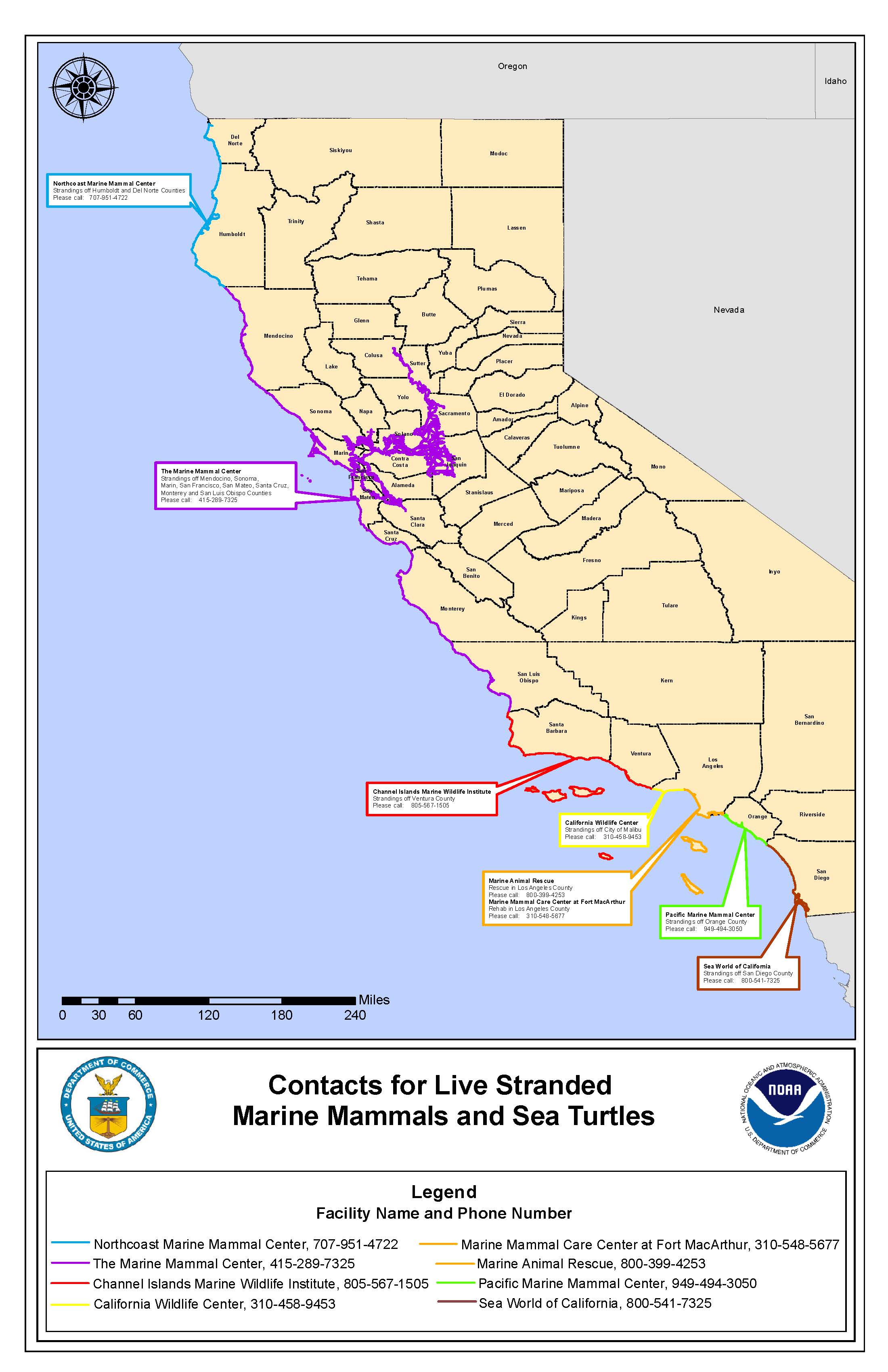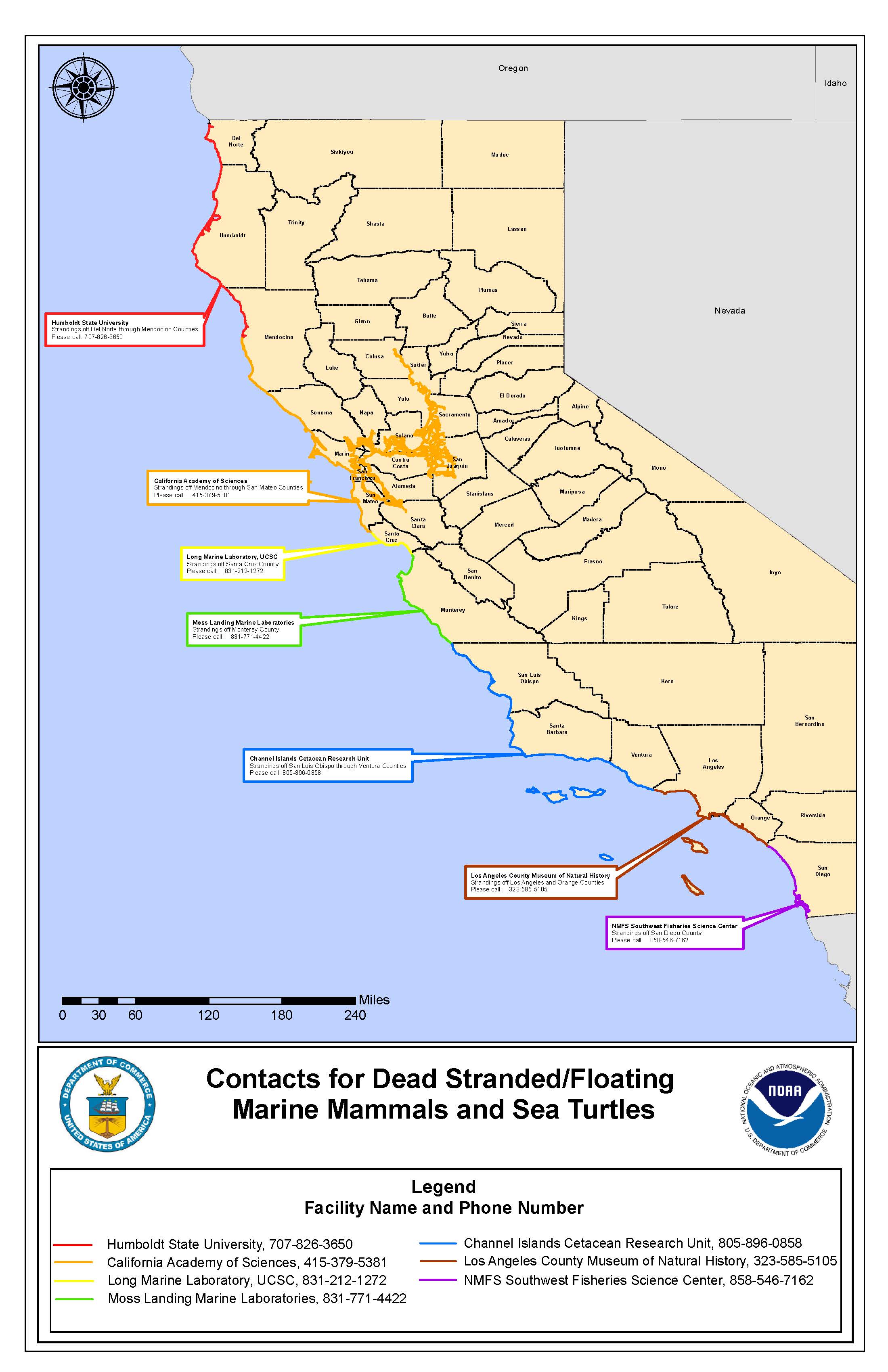JUNE HIGHLIGHTS
Pseudo-nitzschia -
- C-HARM tells us where conditions are suitable for species of the diatom Pseudo-nitzschia spp. (all size classes) to grow well and where they might be more likely to produce the deadly neurotoxin, domoic acid (DA).
- C-HARM predictions for Pseudo-nitzschia spp. blooms in June painted a much more variable outlook than in previous months. An obvious emerging pattern was a mid-month peak in probabilities along the central coast, at times very high in the northern California nearshore coastal zone. This was followed by a shift towards cells of high bloom probabilities along the North Coast and in the Southern California Bight.
- HABMAP pier sampling only captured bloom levels of Pseudo-nitzschia spp. at Cal Poly Pier and Stearns Wharf (Santa Barbara) in mid-June. This is consistent with C-HARM foci for potential bloom activity in central California, although the predicted shift north and south of high bloom potential at the end of June was not captured at the piers and ad-hoc bay sampling.
- Pseudo-nitzschia activity from CDPH sampling pointed to possible bloom activity for the 'seriata' group at one central CA site - Morro Bay, which is consistent with Pseudo-nitzschia bloom predictions from C-HARM but does not match up with bloom predictions elsewhere. However, it is important to point out that Pseudo-nitzschia was present at many sites from Santa Barbara north, pointing to the broad habitat envelope for this potentially toxic diatom group.
- The CA Imaging Flow Cytobot Network snapshots from the Monterey Bay offshore MBARI Power Buoy, Santa Cruz Wharf, and Bodega highlighted for June show a mixed assemblage of diatoms at all sites, including Pseudo-nitzschia spp. and several dinoflagellate species at Santa Cruz Wharf.
- C-HARM probabilities for particulate domoic acid (pDA) in June followed a fairly similar pattern to that of Pseudo-nitzschia bloom probability. The northern/central coast from Sonoma County to the Santa Barbara Channel region was a hot spot of potential DA activity for much of the month, with a shift more towards the Southern California Bight (mostly offshore) and North Coast (mostly nearshore) towards late June.
- Just as in May, the pattern for C-HARM predictions of cellular domoic acid (cDA) probability were similar to pDA for June, although the southern California pattern diverged a bit with very low probabilities for high cDA during much of the month, especially as pDA probabilities increased in the Bight and cDA probabilities bounced between low to mid-range. This suggests that while the Pseudo-nitzschia populations in southern California may have been producing domoic acid and accruing a lot of biomass simultaneously, the per cell DA production may not have been keeping up with the bulk levels of DA present.
- As we have seen for some time, for all the sites where domoic acid data are available from HABMAP pier sites in June, no DA was detected. Note that most DA results processed for June only covered the 1st of June, so it still hard to say if things changed at the piers or in the bays. This does not preclude the production of DA offshore of the pier sites.
- Four potential DA toxicosis cases were reported, 3 California Sea Lions in San Diego and 1 Northern Guadalupe Fur Seal in central CA, all in the last half of June. Notably, CWC in Malibu recovered several deceased California Sea Lions in June, but necropsy results are still pending. The DA toxicosis cases are consistent with a shift to high pDA probabilities in the Southern California Bight at the end of June. Central CA pDA probabilities were high for most of June, which is consistent with the TMMC fur seal case.
- Note that CDPH lifted the razor clam domoic acid health advisory on June 27th, but the annual quarantine on consuming recreational mussels is still in effect until October.
Alexandrium -
- CDPH detected "Present" relative abundances of Alexandrium spp. at central and southern California collection sites in June. This is consistent with HABMAP sampling at Scripps Pier, Stearns Wharf, Cal Poly Pier, and Santa Cruz Wharf. There are currently no advisories for Paralytic Shellfish Poisoning.
Summary written by Clarissa Anderson on July 25, 2022
Note that data for some stations are not shown because they are not yet recorded in the public HABMAP archive.
Differentiating Pseudo-nitzschia species by light microscopy is difficult. For this reason, Pseudo-nitzschia "seriata" does not refer to an actual species but rather the larger size class of Pseudo-nitzschia, which is generally a more toxigenic group of species. Alternatively, Pseudo-nitzschia "delicatissima" refers to the smaller size class that is generally non-toxigenic. The dashed line on the plots demarcates the 10,000 cells/L "bloom" threshold designated here for Pseudo-nitzschia populations only.
More information and data visualizations on the statewide HAB network and forecasting system can be found on the California HABMAP website and on the SCCOOS Harmful Algal Bloom page.
Four water samples were collected at Bodega Marine Lab in June. Pseudo-nitzschia "delicatissima" and Pseudo-nitzschia "seriata" were detected on each occasion (June 6, 13, 20, 27) below the bloom threshold. Alexandrium spp. were not detected. Domoic acid results are pending.
The Bodega Marine Lab shore station is supported by CeNCOOS PI John Largier.
Five water samples were collected at Santa Cruz Wharf in June. Molecular probes for toxigenic Pseudo-nitzschia in the "seriata" class are conducted for this site, and was not detected. Alexandrium spp. were detected three times (June 15, 22, 29). Domoic acid was detected once on June 1, but additional sample are pending.
The Santa Cruz Wharf shore station is supported by CeNCOOS PI Raphael Kudela at UCSC
Four water samples were collected at Cal Poly Pier in June. Pseudo-nitzschia "delicatissima" was detected twice (June 14, 22) below the bloom threshold. Pseudo-nitzschia "seriata" was detected once (June 14) above the bloom threshold. Alexandrium spp. were detected twice (June 22, 28). Domoic acid results are pending.
Cal Poly Pier shore station is supported by SCCOOS and PI Ally Pasulka at Cal Poly.
Four water samples were collected at Stearns Wharf in June. Pseudo-nitzschia "delicatissima" was detected on three occasions (June 6, 14, 21), with June 14 above the bloom threshold. Pseudo-nitzschia "seriata" was also detected on three occasions (June 6, 14, 21), all below the bloom threshold. Alexandrium spp. were detected only on June 6. Domoic acid was not detected.
Stearns Wharf is supported by SCCOOS and PIs Mark Brzezinski and Libe Washburn at UCSB.
Four water samples were collected at Newport Beach Pier in June. Pseudo-nitzschia "delicatissima" and "seriata" were not detected in the first sample (June 6). Alexandrium spp. and domoic acid were also not detected in the first sample. Additional results are pending.
Newport Beach Pier is supported by SCCOOS and PI David Caron at USC.
Four water samples were collected at Scripps Pier in June. Pseudo-nitzschia "delicatissima" was detected twice (June 13, 27) below the threshold. Pseudo-nitzschia "seriata" was detected once (June 27), also below the threshold. Alexandrium spp. were detected twice (June 6, 13). Domoic acid was not detected in the first sample (June 6) but additional results are pending.
Scripps Pier is supported by SCCOOS and PIs Melissa Carter and Clarissa Anderson at UCSD.
CDPH observations for Pseudo-nitzschia "seriata" and Alexandrium spp.
View the interactive map and data table of California Department of Public Health (CDPH) data from January 2019 to present, developed by SCCOOS, below. Or, view CDPH Toxic Phytoplankton Observations Map with layers of Pseudo-nitzschia and Alexandrium spp. as well as other phytoplankton species observations (in the pop-up windows).
Data are provided by the Environmental Management Branch of the CDPH. Please note, starting in July 2019, CDPH moved to only reporting Pseudo-nitzschia of the seriata complex and not all Pseudo-nitzschia spp. as previously provided.
Please email CDPH at Susan.Paulukonis@cdph.ca.gov for any potential marine HAB-related illness in humans.
From June 1-30 2022, water samples were collected by volunteers and sent to the California Department of Public Health (CDPH) for analysis.
Pseudo-nitzchia "seriata" group was detected in 34 of the 101 samples:
Pseudo-nitzschia "seriata" was detected at "Common" density levels once:
- 2022-06-13 20% Morro Bay, Boat Launch
Pseudo-nitzschia "seriata" was detected at "Present" density levels on 15 occasions:
- 2022-06-06 1% Tomales Bay, Lease #M430-15
- 2022-06-08 2% Santa Barbara, Mohawk Reef
- 2022-06-10 8% San Simeon Pier
- 2022-06-13 3% Cayucos Pier
- 2022-06-13 3% Pismo Pier
- 2022-06-18 1% GFNMS, Marin Line N2WN
- 2022-06-18 5% GFNMS, Marin Line 2E
- 2022-06-18 5% Marin, OFFSHORE
- 2022-06-22 5% Port San Luis, Diablo Cove
- 2022-06-22 9% Pacifica Pier
- 2022-06-23 2% San Simeon Pier
- 2022-06-23 2% Sonoma, OFFSHORE
- 2022-06-29 1% Santa Cruz Wharf
- 2022-06-29 2% Morro Bay, North T-Pier
- 2022-06-30 4% Port San Luis, Diablo Cove
Pseudo-nitzschia "seriata" was detected at "Rare" density levels on 18 occasions:
- 2022-06-01 0.5% Goleta Pier
- 2022-06-03 0.5% San Simeon Pier
- 2022-06-05 0.5% Pacifica Pier
- 2022-06-06 0.5% Morro Bay, Boat Launch
- 2022-06-08 0.5% Goleta Pier
- 2022-06-08 0.5% Santa Cruz, Capitola Pier
- 2022-06-09 0.5% Drakes Bay, Chimney Rock LBS
- 2022-06-16 0.5% Santa Cruz, Seacliff Pier
- 2022-06-16 0.5% Santa Cruz Is., Prisoners Hrbr
- 2022-06-17 0.5% San Simeon Pier
- 2022-06-19 0.5% GFNMS, San Mateo Line 10W
- 2022-06-20 0.5% Morro Bay, Boat Launch
- 2022-06-21 0.5% GFNMS, Marin Line 1E
- 2022-06-22 0.5% GFNMS, Sonoma Line 15-W
- 2022-06-23 0.5% GFNMS, Sonoma Line 13E
- 2022-06-29 0.5% Santa Barbara, Mohawk Reef
- 2022-06-29 0.5% Monterey, Stillwater Cove
- 2022-06-29 0.5% Santa Cruz Is., Prisoners Hrbr
Alexandrium spp. were detected in 15 of the 101 samples:
Alexandrium spp. were not detected at "Common" density levels.
Alexandrium spp. were detected at "Present" density levels on 8 occasions:
- 2022-06-01 3% Goleta Pier
- 2022-06-02 1% Imperial Beach Pier
- 2022-06-06 1% La Jolla, Scripps Pier
- 2022-06-10 1% San Simeon Pier
- 2022-06-13 2% Pismo Pier
- 2022-06-14 5% Santa Monica Pier
- 2022-06-15 1% Imperial Beach Pier
- 2022-06-30 2% Port San Luis, Diablo Cove
Alexandrium spp. were detected at "Rare" density levels on 7 occasions:
- 2022-06-08 0.5% Imperial Beach Pier
- 2022-06-08 0.5% Santa Barbara, Mohawk Reef
- 2022-06-16 0.5% San Clemente Pier
- 2022-06-17 0.5% San Simeon Pier
- 2022-06-22 0.5% Port San Luis, Diablo Cove
- 2022-06-27 0.5% Newport Bay, Back Bay
- 2022-06-29 0.5% Pacific Beach Pier
CDPH and OEHHA Health Advisories
June 27. The California Department of Public Health (CDPH) has lifted the shellfish safety notification related to sport-harvested razor clams in Del Norte County.
April 26. The California Department of Public Health (CDPH) today announced the annual quarantine of sport-harvested mussels gathered along the California coast beginning May 1.
April 2. The California Department of Public Health (CDPH) warned consumers today not to eat raw oysters from British Columbia, Canada because they may be linked to an outbreak of norovirus illnesses in California. Canadian officials continue to investigate the source of norovirus illnesses and have closed multiple growing regions in British Columbia for sanitary contamination.
December 16. The California Department of Public Health (CDPH) is advising consumers not to eat sport-harvested razor clams from Del Norte County due to dangerous levels of naturally occurring domoic acid, also referred to as Amnesic Shellfish Poisoning, being detected.
November 29. The California Department of Public Health (CDPH) has lifted the shellfish safety notification for Dungeness crab caught in state waters from the Sonoma/Mendocino County Line (38° 46.125' N. Latitude) to Point Reyes (38° N. Latitude) in Marin County.
November 5. Due to the detection of elevated levels of domoic acid, a naturally occurring toxin, the California Department of Public Health (CDPH) is warning consumers not to eat the viscera (internal organs) of Dungeness crab caught in coastal waters.
For the latest closures and updates, please visit the CDPH Health Advisories page as a central location of information related to CDPH health advisories. Also available is a map showing the current CDPH Recreational Bivalve Shellfish Advisories (see below).
The HAB-related illness workgroup has developed a new webpage for marine HAB-related illness tracking work (https://oehha.ca.gov/fish/general-info/marine-harmful-algal-bloom-hab-related-illness-tracking).
A network of Imaging FlowCytobots (IFCBs) continuously photographs particles, such as plankton, in the water. Using machine learning, plankton species can be automatically identified. This will help improve the ability to detect and respond to Harmful Algal Blooms, including the ability to assess conditions that may lead to toxin production or blooms of toxin-producing algae.
Additional images and data are available on the IFCB dashboard.
A sampling of IFCB images from northern CA sites in June, capturing a range of diatom and dinoflagellate species, including Pseudo-nitzschia spp.
Domoic acid (DA) is a potent neurotoxin produced by some diatom species of the genus Pseudo-nitzschia. Species exposed to DA can result in seizures, epilepsy, cardiomyopathy, and death depending upon the ingested dose. DA toxicosis commonly occurs in California Sea Lions (Zalophus californianus), presumably due to a combination of foraging behavior and seasonal movements. The Marine Mammal Center (TMMC), Channel Islands Marine Wildlife Institute (CIMWI), California Wildlife Center (CWC), Marine Mammal Care Center Los Angeles (MMCC-LA), Marine Animal Rescue (MAR), the Pacific Marine Mammal Center (PMMC), SeaWorld, and Southwest Fisheries Science Center (SWFSC) act like an emergency room by working to rescue and rehabilitate sick and injured marine mammals, seabirds, and sea turtles.
CIMWI, MMCCLA, PMMC, and CWC did not record any strandings due to suspected domoic acid in June 2022. Results from SWFSC and MAR are pending.
June strandings due to suspected DA toxicosis occurred in the following counties:
- San Diego (SeaWorld)
- June 20 - Adult, female, California Sea Lion
- June 20 - Pup, California Sea Lion
- June 23 - Adult, female, California Sea Lion
- Santa Cruz (TMMC)
- June 24 - Adult, female, Northern Fur Seal
CWC reported several DOA California Sea Lions in June.

